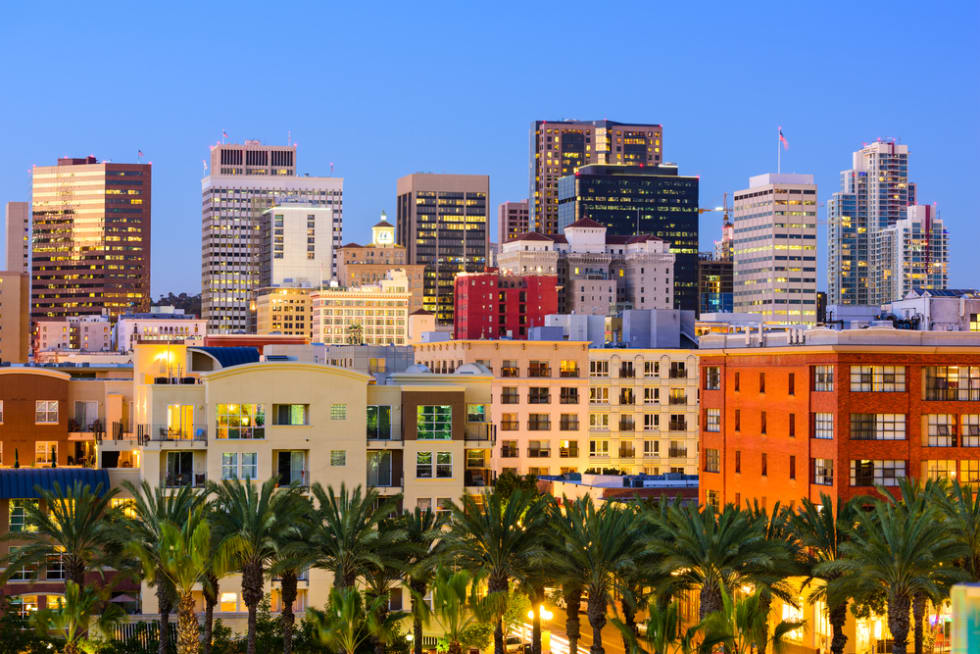Rivair Apartment Homes
- 49 units available
- Studio • 1 bed • 2 bed
- Amenities
In unit laundry, Patio / balcony, Dishwasher, Pet friendly, New construction, Garage + more

If you’re thinking of moving to the West Coast, the cost of living in San Diego, CA is 54.9% higher than the U.S. average. Nicknamed America's Finest City, San Diego is among the country's most popular and expensive cities to live in.
San Diego locals consider themselves lucky to live along sparkling coastlines, soaking up an average of 266 days of sunshine each year. The city draws a mix of college students, young professionals, retirees, and veterans looking to call this coastal city home.
Yet, despite its higher cost of living, it’s still cheaper than other California hotspots like San Francisco. Ready to make your move? Here’s a breakdown of the cost of living in San Diego and what to expect from your budget.

According to data from Best Places, San Diego’s overall cost of living index is 154.9, which makes it 54.9% above the U.S. average and 3.3% higher than the California state average.
On a monthly basis, a single adult in San Diego spends around $7,000 on essentials like housing, food, utilities, and transportation, while a family of four needs closer to $13,320 per month, or about $159,840 annually. Here’s a breakdown of the budget categories.
| Cost of Living | San Diego | California | U.S. |
|---|---|---|---|
| Overall | 154.9 | 149.9 | 100.0 |
| Grocery | 109.7 | 105.1 | 100.0 |
| Health | 89.0 | 98.3 | 100.0 |
| Housing | 278.4 | 234.8 | 100.0 |
| Median Home Cost | $833,500 | $733,500 | $338,100 |
| Utilities | 102.8 | 102.4 | 100.0 |
| Transportation | 120.2 | 133.1 | 100.0 |
| Miscellaneous | 153.9 | 118.7 | 100.0 |
Source: BestPlaces
If you’re looking at the upper end of the rental market, Carmel Valley is one of the most expensive neighborhoods in San Diego. The average rent here is $3,906, well above the citywide median.
These higher rents typically come with newer builds and premium amenities, such as stainless steel kitchens, in-unit laundry, resort-style pools, and fitness centers. Carmel Valley’s location also means quick access to upscale shopping, dining, and top-rated schools.
On the other side of the spectrum, Mira Mesa stands out as a more affordable option for budget-conscious renters. The average rent here is $2,908, nearly $1,000 less than Carmel Valley. That savings adds up to more than $11,900 annually compared to the city’s higher-end neighborhoods.
Mira Mesa offers a strong balance between price and livability. Lower rents free up more of the household budget for savings, entertainment, or travel. The neighborhood is also known for its suburban backdrop, dining, and proximity to tech hubs like Sorrento Valley.
San Diego is known for some of the highest rent prices in the United States. According to our database of rental estimates, the average rent rate in San Diego is $2,329 as of September 2025, with one-bedrooms costing around $2,930 and two-bedrooms running $3,861 a month.
San Diego rents vary depending on your neighborhood, as well as the type of apartment you choose. Apartments near the beach or popular shopping complexes come at a premium. However, moving inland will reduce your costs.
If you're looking for a short-term rental, you're in luck. San Diego's warm-weather market draws short-term visitors and makes it easier than other cities to find month-to-month leases.
You may end up paying a premium for flexibility. However, you can take your time exploring neighborhoods before signing a year-long lease.
| Unit Type | San Diego Average Rent | National Average Rent |
|---|---|---|
| Studio | $2,440 | $1,665 |
| 1-Bedroom | $2,930 | $1,757 |
| 2-Bedroom | $3,861 | $2,194 |
| 3-Bedroom | $5,174 | $2,689 |
A one-bedroom apartment averages $2,930 per month, compared to the national average of $1,757. That makes San Diego nearly 67% more expensive at this size. With demand high across coastal neighborhoods, renters often share space or move inland to offset the cost.
A two-bedroom apartment averages $3,861 per month, well above the national average of $2,194. Families, couples, or roommates looking for two-bedroom units face some of the steepest rental premiums in the country. Choosing neighborhoods farther from the beach or downtown can make affording these units more manageable.
San Diego is known for its high cost of living, which requires a decent salary to enjoy what the city offers. Figuring out how much you need to earn can be accomplished using the average rent in an area. For example, if your one-bedroom rent runs the current average of $2,930, your yearly salary should be around $117,200 annually before taxes to comfortably afford rent, bills, savings, and entertainment.
These rent and salary figures consider that you shouldn't spend more than 30% of your monthly income on rent. Grab a calculator and multiply your rent by three to ensure it falls within this 30% rule. Use our rent calculator to explore more pricing.
You should also consider the living wage, which is the bare minimum needed to cover expenses like housing, food, and transportation. According to MIT’s data, a single adult in San Diego County needs $30.71 per hour, or about $63,876 annually, to cover basics like housing, food, and transportation.
For context, the U.S. Census Bureau reports that the median household income in San Diego is $111,032, or about $9,253 a month. That puts many households above the living wage threshold but below what’s often required to comfortably afford housing at market rates.
The small pool of housing inventory and low mortgage rates drive the demand for home purchases. The current average home price in San Diego is $833,500.
Renters looking to step into homeownership face stiff competition around San Diego, as the city's home prices continue to rise and outpace much of Southern California.
Expect to spend approximately $10,720 per year on transportation as a single adult. However, if you have a family with two working adults and one child, your transportation cost will increase to $17,982 per year.
Like many cities in California, San Diego is notorious for heavy traffic. The good news is, locals can get around the city by walking or public transportation. To avoid driving and getting stuck in rush hour traffic, hop on the MTS—Metropolitan Transit System with buses and trolleys. Expect to pay $72 per month for a local monthly pass or $2.50 for a single one-way trip.
Not all of San Diego is walkable. However, there are still charming neighborhoods to choose from. Both Little Italy and the historic Gaslamp district boast a walk score of 98. Harborview, Marina, Cortez Hill, East Village, and La Jolla are also among San Diego's walkable areas.
MIT living wage estimates a single full-time working adult in San Diego that cooks their meals and snacks spends around $4,507 per year on food. A family with two working adults and two children will spend $13,212 on food per year. Like most of California, grocery prices are also high in San Diego.
However, if you want to take advantage of San Diego's thriving food scene, expect to spend $21 for a meal at an inexpensive restaurant. A meal for two people at a mid-range restaurant costs around $96.
San Diego is one of the best foodie cities in the country. Locals dig into incredible seafood, Mexican dishes like carne asada, and wood-fired California-style pizza.
There are also plenty of local wineries and breweries to explore in the greater San Diego area!

To get an idea of what to expect, we looked at MIT's data pulled from the Bureau of Labor Statistics and the Agency for Healthcare Research and Quality. They estimate $2,620 per year for a single full-time working adult and $9,394 per year for a family of four living in San Diego.
Healthcare is a significant expense in most areas. The same holds in the rest of California.
Healthcare costs are rising faster than incomes throughout the state. However, you can offset expenses with an employer-sponsored benefits package.
A standard utility bill for a 915 sq. ft. apartment, including electricity, cooling, heating, garbage, and water, averages around $269.18 per month. Adding internet ($82.19) and mobile service ($73.77) brings the total closer to $425 per month. San Diego's temperate weather and breezy summers will keep your utilities relatively low. Winter temperatures range from 50 to 67 degrees. As a result, locals can enjoy the outdoor lifestyle year-round.
With 70 miles of coastline, San Diego is a fitness lover's dream. Whether you enjoy swimming, jogging, or volleyball games on the beach, there's something for everyone. For a day of hiking and coastal views, try Los Peñasquitos Canyon and Waterfall or Torrey Pines State Park Loop to stay fit and enjoy nature.
If you want the benefit of weights and fitness classes at the gym, expect to pay $73.21 in monthly membership fees.
Entertainment is a big deal around San Diego. Shopping, nightlife, and music reign. If movies are your entertainment of choice, you'll spend about $15.29 per ticket plus extras at the concession stand. Theme parks are also big business in San Diego, with many major attractions to choose from.
The San Diego Zoo costs $71 for a day pass, Belmont Park runs $35 for an unlimited attraction pass, and SeaWorld will set you back $104.99. Disneyland is also just 95 miles away, where tickets start at $119 per adult for a single park.
Taxes are a major factor in San Diego’s overall cost of living. The rest of California has some of the highest income tax rates in the country, and San Diego residents feel that impact alongside the state sales tax. The combined sales tax rate in San Diego is 7.75%, which is above the national median.
On top of that, income tax brackets in California can reach as high as 13.3% depending on earnings, making careful budgeting essential for higher-income households.
Property taxes are more moderate, and San Diego County’s average effective property tax rate is 0.76%, slightly lower than the national average of about 0.99%. Still, with the city’s high median home price of $833,500, homeowners face yearly property tax bills averaging over $6,300.
Together, sales, income, and property taxes add a meaningful layer to San Diego’s already high housing and utility costs. Renters and buyers alike should factor these expenses into long-term affordability planning.

There's good news for job hunters in San Diego looking for a decent salary. Locals enjoy relatively low unemployment rates and a wide range of major employers.
Nearly 85,000 businesses call San Diego home, but a handful stand out as major employers. Tech and electronics employers lead the way with companies, including:
Military and education are also significant sources of employment in San Diego. The United States Navy has a strong presence in the area, as do the University of California in San Diego and the San Diego Unified School District.
If you're dreaming of working in tourism, there are plenty of choices around San Diego. The many theme parks, hotels, restaurants, and nightlife all service the growing tourism industry.
San Diego's stunning landscape and oceanfront breezes make it the perfect place to settle in for California living. However, if San Diego seems too pricey for you, consider other cities in California that may be cheaper.
Are you ready to pack up and see for yourself? Our quiz takes minutes to complete but can save 50 hours of searching. Get started apartment hunting in San Diego today!
San Diego is significantly more expensive than the national average. The city’s cost of living index is 154.9, making it nearly 55% higher than the U.S. average. It’s pricier than most American metros but still less costly than San Francisco or parts of Silicon Valley.
averages $2,930, which means you’d need about $117,200 per year before taxes using the 30% rent rule. MIT also places the local living wage at around $63,876 annually for a single adult covering just the basics.
No, housing is the biggest driver of San Diego’s high cost of living. The median home price is $833,500, far above the national average of $338,100. Limited inventory and strong demand keep both home prices and rents elevated across the region.
Mira Mesa is one of the more affordable areas, with average rents around $2,908. On the other end, Carmel Valley tops the list of expensive neighborhoods with average rents of $3,906. That difference adds up to nearly $12,000 a year in savings for renters who choose budget-friendlier parts of the city.
Utility costs are moderate compared to other big cities. A 915-square-foot apartment runs about $269 a month for basic services, with internet and phone pushing the total to around $425. The mild climate helps keep heating and cooling costs lower year-round.
Transportation averages about $10,720 per year for a single adult. Commuters spend more if they drive due to traffic, gas, and parking costs. A monthly MTS transit pass is $72, making public transit the cheaper option for many locals.
Yes, food costs run higher than the U.S. average. A single adult spends about $4,500 a year on groceries, while a family of four spends over $13,000. Eating out adds to the budget—expect $21 for a casual meal or nearly $100 for a mid-range dinner for two.
Taxes play a big role in San Diego’s cost of living. The sales tax rate is 7.75%, and California’s income tax can reach up to 13.3% for top earners. Property taxes are lower at 0.76%, but high home prices mean average annual bills still exceed $6,300.


In unit laundry, Patio / balcony, Dishwasher, Pet friendly, New construction, Garage + more
In unit laundry, Nest technology, Patio / balcony, Pet friendly, Garage, Stainless steel + more